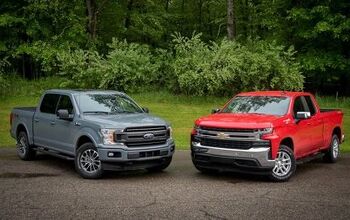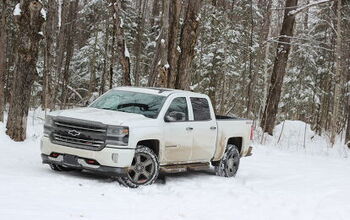Chevrolet Silverado EV vs Ford F-150 Lightning Comparison

Co-Written with Mike Schlee
It’s the classic Ford versus Chevy face-off, with a twist. Trucks are the new family vehicle, and EVs are making up more and more of new car sales, so we’ve pitted the venerable Ford F-150 Lightning against its biggest—literally—competitor, the Chevrolet Silverado EV.
Chevrolet Silverado EV vs Ford F-150 Lightning Quick Take
Despite both borrowing the names of their gas-powered siblings, the Chevrolet Silverado EV and Ford F-150 Lightning take different approaches to the electrified pickup. Which one is better for you truly depends on your priorities.
What’s New for 2025:
For the Lightning? Not a whole lot. Ford’s electric F-150 has been around for a few years now, and while there have been regular tweaks, we haven’t seen a major update since the 2022 debut. A value-oriented Flash model recently joined the ranks, slotting in between the XLT and Lariat trims with a power rating (536 horsepower) and range (300 miles / 484 kilometers) to match. Our tester is actually a 2024 model, though there are no significant differences between it and the latest examples.
As the newer of the two, the Silverado EV sees bigger changes, with the introduction of the lower-cost LT trim as well as a standard-range battery pack.
2025 Chevrolet Silverado EV RST: All the Details
Exterior Style:
Do you like the current (pre-facelift) F-150, but wish it had a bit more fluorescent-overhead-lighting feel to its face? Well then the Lightning is for you. Ford’s design team has kept the EV looking almost exactly like the gas model, with the addition of full-width light bars at both ends. It seems like one of the only requirements to join the EV truck crew is a headlight bar…
The Chevrolet Silverado EV leans heavier into the futuristic, electric-oddball styling than the more traditional F-150. From its profile, the Silverado EV has an incredible resemblance to another Chevrolet pickup truck of the past, the Avalanche. Heck, it even has a multi-flex mid-gate like the one in the Avalanche.
2024 Ford F-150 Lightning: All the Details
Powertrain and Fuel Economy:
Let’s get it out of the way right now: yes, when the Chevy is in its full-on, impress-your-friends silly launch mode, it is quicker than the Ford. Even while it’s hauling around an entire compact car’s worth of extra weight, the Silverado scoots, ripping off runs to 62 mph in under five seconds—and feeling just a little bonkers while it does it.
Yet everywhere else, these two are essentially equal: the Lightning puts down its 580 horsepower and 775 pound-feet all the time, not just in certain modes. The F-150 benefits from a more natural-feeling accelerator too, making it easier to trundle around town. One-pedal driving is a simple tap away, with strong but not overly aggressive deceleration.
Even in this most efficient long-range, Lariat trim, the Lightning can’t match the Chevy’s camel-like longevity. Officially it will still do 320 miles (515 kilometers), which isn’t bad considering its battery pack is “just” 131 kWh in capacity.
Power is a bit hard to pinpoint with the Chevrolet Silverado EV. Officially, the RST Max like our tester makes 760 hp and 785 lb-ft of torque. But that amount of power is only available during the Wide Open Watts (WOW) launch. Otherwise, power is significantly lower, we would estimate somewhere in the 500-550 range.
All that power comes from a battery that once again is shrouded in mystery. We know it’s a 24-cell unit, but exactly how many kWh, we don’t know. Our best estimate is in the 200 kWh range. That big battery also leads to big range: 460 miles (740 km) estimated.
Both of these particular trims can tow up to 10,000 pounds when properly equipped.
Handling and Drivability:
While I stand firm that the Lightning is the best-driving F-150, that’s the thing: it still, largely, feels like an F-150. It turns in like a truck, just one with all its weight better distributed across its floor than in its nose. The wheel has exactly as much weight and feedback as any other of America’s favorite pickup, and that will make the Lightning instantly familiar to a great many people.
The Silverado EV drives bigger than the F-150. True, the Chevy is bigger than the Ford, but behind the wheel the size difference is exaggerated. Even with wide tires on 24-inch wheels, the Silverado EV isn’t exactly an adapt handler. It’s a truck after all, even if it is a unibody, and tackling corners aren’t a priority. That stated, with a curb weight in the over-8,000 pound neighborhood, it’s fairly responsive and easy enough to drive.
When out filming, we appreciated the Chevy’s four-wheel steering, making quick turn-arounds a cinch. Sidewinder mode remains a fun gimmick to showcase to friends, and that’s about it.
Ride Quality and Comfort:
The F-150 Lightning forced my wife to invent a new term for a press car: “jiggle beast.” Navigating the uneven, lumpy roads around our neighborhood, I couldn’t argue with her. This might be the best-driving F-150, but it still shakes and shimmies like a truck. Sure enough, finding smoother roads and—especially—on the highway, the Lightning calms down and proves exceptionally smooth.
Modern full-cab trucks have some of the most spacious second-row seats, and the Lightning is no different. I find the back seats slightly better than those in the Chevy: space is broadly similar (and very adult-friendly), but the Ford’s more upright design affords back-seat passengers more surrounding glass and thus, a more inviting space.
There’s no contest as to which truck has a smoother ride: the Silverado EV. With an air suspension and (quasi-)unibody construction, the Chevrolet rides more like a family SUV than a traditional truck. Inside, there’s plenty of space for front seat passengers while those in the rear have a ridiculous amount of real estate.
Interior Style and Quality:
It’s an F-150. Seriously, beyond the lack of engine noise, frunk button, and any EV-related screen graphics, the cabin of the Lightning is indistinguishable from an ICE-powered truck, right down to that fold-away shifter. Again, part of the appeal. The current F-150 has a clean and conservative interior design with slivers of wood and contrast stitching for some welcome highlights. There aren’t many physical controls, as nearly everything is accessed via the portrait-style touchscreen. The aforementioned shifter, while useful for the workspace it can create, always feels loose, and as a regular touchpoint, that affects the feeling of quality.
The Silverado EV’s interior is less wild than the exterior. It’s still the more stylish of the two trucks and Mike prefers the way the digital driver information center and horizontal infotainment system are designed/laid out. “I also prefer the user interface on the Chevy unit,” says Schlee, and I can’t really argue with him. While the Ford’s setup is pleasantly simple, there’s a stronger sense of logic to how the Chevy’s system operates. While some of that would be ironed out during ownership, we both agree the initial learning curve is simply flatter in the Chevy.
Both trucks have hard plastics in places that seem out of place for this price bracket. With the Silverado EV, it’s especially noticeable on the rear doors.
Tech and Safety:
This being a Lariat, the Lightning is reasonably well-equipped but still missing a few niceties found on the top Platinum, like the massage seats, 14-speaker B&O sound system, and leather seats. The heated and ventilated front seats are very effective, with both settings necessary during the week. Ford’s various towing assists are also both useful and easy to use. One of the few options on this Lariat tester is the 9.6-kW Pro Power Onboard, turning the Lightning into a useful generator for the house or worksite.
The Chevy has some tech the F-150 does not, like a head-up display. It’s also missing some highly desired tech like Apple CarPlay. “I will not relent on this topic until Chevrolet reverse the brand’s decision to exclude Apple CarPlay from the manufacturer’s electric vehicles,” declares Schlee, adding “having built-in Google and free data is not the same convenience as simply have a user’s phone pair up every time they enter the truck.” Not to be outdone, the Silverado has 10.2 kW of available off-board power.
“Super Cruise: ‘nough said,” chimes Schlee. The F-150 has BlueCruise too, so both rigs do the hands-free highway thing well. Chevy’s system is just that bit more refined however, and the interface with the light-up steering wheel rim is all too easy to understand.
Value Dollars and Sense:
Neither of these trucks is what you’d call affordable—but then again, that’s true of any full-size high-trim pickup these days.
The Ford rings up at $81,710 ($105,790 CAD) including destination, with only a handful of options, including the red paint ($495 / $600 CAD), Pro Power Onboard ($1,200 / $1,200 CAD), and bedliner ($600 / $625 CAD).
The Silverado has even fewer options available, and still rings in at $97,895 ($120,499 CAD) including destination. This is the current tippy-top of the EV lineup however; work truck trims start at about two-thirds of this.
Final Thoughts: Chevrolet Silverado EV vs Ford F-150 Lightning Comparison
After spending a week with these two electron-munching behemoths, the conclusion was obvious: the F-150 Lightning is a truck that happens to be electric, while the Silverado EV is, er, an EV that happens to be a truck.
This is no bad thing: if anything, given the relatively small size of the electric truck market, it’s good these two serve to complement each other. If you’re honest about the amount of actual “truck stuff” you need to do with your pickup and the answer is “almost none”, then the Silverado is the smoother and friendlier daily driver—assuming it will fit everywhere. Planning on putting your electric truck to work more often? The Lightning is still our pick.
Become an AutoGuide insider. Get the latest from the automotive world first by subscribing to our newsletter here.
Category | 2025 Chevrolet Silverado EV RST Max | 2024 Ford F-150 Lightning Lariat |
|---|---|---|
Powertrain | 9 / 10 | 8 / 10 |
Efficiency | 7 / 10 | 8 / 10 |
Handling and Drivability | 8 / 10 | 7 / 10 |
Passenger Comfort | 7 / 10 | 8 / 10 |
Ride Quality | 4 / 5 | 3 / 5 |
Exterior Style | 4 / 5 | 4 / 5 |
Interior Style and Quality | 8 / 10 | 8 / 10 |
Infotainment | 8 / 10 | 8 / 10 |
Cargo Capacity and Towing | 4 / 5 | 4 / 5 |
Safety | 4 / 5 | 4 / 5 |
Value | 6 / 10 | 7 / 10 |
Emotional Appeal | 7 / 10 | 7 / 10 |
TOTAL | 76 / 100 | 76 / 100 |
Specifications | ||
|---|---|---|
2025 Chevrolet Silverado EV RST Max Range | 2024 Ford F-150 Lightning Lariat | |
Motor: | 2x electric motors | 2x electric motors |
Output: | 760 hp, 785 lb-ft | 580 hp, 775 lb-ft |
Drivetrain: | 4WD | 4WD |
Transmission: | 1AT | 1AT |
Battery Capacity: | >200 kWh (est) | 131 kWh |
Range: | 460 mi / 760 km | 300 mi / 515 km |
Starting Price (USD): | $75,195 (inc. dest.) | $65,540 (XLT, inc. dest.) |
As-Tested Price (USD): | $97,895 (inc. dest.) | $81,710 (inc. dest.) |
Starting Price (CAD): | $94,999 (inc. dest.) | $72,890 (inc. dest.) |
As-Tested Price (CAD): | $120,499 (inc. dest.) | $105,790 (inc. dest.) |

Kyle began his automotive obsession before he even started school, courtesy of a remote control Porsche and various LEGO sets. He later studied advertising and graphic design at Humber College, which led him to writing about cars (both real and digital). He is now a proud member of the Automobile Journalists Association of Canada (AJAC), where he was the Journalist of the Year runner-up for 2021.
More by Kyle Patrick












































Comments
Join the conversation
“Let’s get it out of the way right now: yes, when the Chevy is in its full-on, impress-your-friends silly launch mode, it is quicker than the Ford.”
^ should read “Let’s get it out the way right now: no, I didn’t do any research before writing this article.”
Even in WOW mode, the Silverado EV has a 0-60 time of ~4.5 seconds, while the Lightning clocks in at ~3.8 seconds.